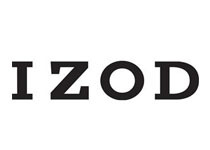Izod
Accessories / Active Wear / Apparel / Bags / Denim
Since its introduction in the United States almost 80 years ago, IZOD has evolved from an idea sprung from the imagination of an apparel executive to a sportswear authority, becoming an American ap...
Since its introduction in the United States almost 80 years ago, IZOD has evolved from an idea sprung from the imagination of an apparel executive to a sportswear authority, becoming an American apparel institution in the process. IZOD has made its reputation as the standard in sportswear, with bold, colorful and energetic design. IZOD offers classic sportswear, athletically inspired golfwear, jeanswear, performance wear, and luxury style sport collections with the clean, youthful design aesthetic that has come to be synonymous with the brand. IZOD's roots goes back to Arthur James "Jack" Izod's bespoke tailor shop in London, where Jack Izod produced shirts and held a royal warrant to provide shirts to the royal household. A visiting executive from David Crystal Inc. became intrigued by the name and purchased the rights to it. The Izod of London mark was initially applied to a successful line of women's shirts and then expanded to include menswear and childrenswear. David Crystal Inc. first added color to the line and subsequently coupled the brand with the Lacoste brand in order to broaden selection and appeal. IZOD's athletic roots and colorful persona were thus first formed. Now associated with the legendary French tennis player René Lacoste but still lagging in sales, the David Crystal executive began giving away the shirts to famous people, including, the Duke of Windsor, Sam Snead, Ben Hogan and Bing Crosby; the shirts began to resonate with consumers. Over time, the shirts became popularized as IZOD shirts and, by the 1980's, they had become a signature piece of "preppy" wardrobes in the United States. When the preppy look began to fade at the end of the decade, so did the brand's sales. IZOD's owner, at this point known as Crystal Brands, split the brands in the early 1990's in an effort to maintain market share, marketing the similarly designed goods at different price points and in different channels but without success. Lacoste was sold and then, in 1995, PVH purchased IZOD.Brand Details
Founder
Vincent De Paul Dradd
Brand Strategy
Market segment
Premium
Core business
Apparel
Targets
Men
